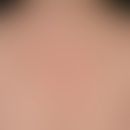Synonym(s)
HistoryThis section has been translated automatically.
Sabouraud 1905
DefinitionThis section has been translated automatically.
Rare, usually sporadic (familiality has been described), congenital, frontotemporal, hypotrichotic site(s) ( atrichia).
You might also be interested in
EtiopathogenesisThis section has been translated automatically.
A nevoid developmental disorder of the Veullushhar follicles to terminal hair follicles with predilection for the frontotemporal course of the Blaschko lines is assumed.
ManifestationThis section has been translated automatically.
Manifestation immediately from birth.
LocalizationThis section has been translated automatically.
Especially frontoparietal and temporal.
ClinicThis section has been translated automatically.
Rare, mostly unilaterally localized, triangular, sharply defined, frontoparietal hypotrichozone. In the affected areas there is a thin stock of vellus hairs. Hypotrichia is noticed in about 50% of the patients only in infancy (more rarely in adulthood). Congenital lack of hair on other parts of the body (axillae) is also described(Alopecia congenita axillaris). The affected areas show no growth in size.
HistologyThis section has been translated automatically.
Normal structured surface epithelium. Instead of the expected terminal hair follicles, small vellus hair follicles are found. No inflammatory phenomena.
Differential diagnosisThis section has been translated automatically.
Alopecia areata; Aplasia cutis;
TherapyThis section has been translated automatically.
Note(s)This section has been translated automatically.
In individual cases associations with phacomatosis pigmentovascularis and Down syndrome have been described.
LiteratureThis section has been translated automatically.
- Karadağ Köse Ö et al. (2014) Temporal triangular alopecia: significance of trichoscopy in differential diagnosis. J Eur Acad Dermatol Venereol 29: 1621-1625
- Singh N et al (2016) Congenital triangular alopecia: Is it always confined to fronto-temporal region? Indian J Dermatol Venereol Leprol. 82:112
- Unger R et al (2011) Bilateral Temporal Triangular Alopecia Associated with
- Phacomatosis Pigmentovascularis Type IV Successfully Treated with Follicular Unit Transplantation. Case Rep Dermatol Med: 129541
- Shanshanwal SJ det al (2017) Case of Unilateral Temporal Triangular Alopecia. Indian Dermatol Online J 8:161.
- Yamazaki M et al (2010) Temporal triangular alopecia and a review of 52 past cases. J Dermatol 37:360-362
- Yin Li VC et al (2015) Congenital Triangular Alopecia. Int J Trichology. 7:48-53
Incoming links (6)
Alopecia congenita; Alopecia congenita triangularis; Alopecia triangularis temporalis congenitalis; Atrichie; Atrichie maculeuse; Temporal triangular alopecia;Disclaimer
Please ask your physician for a reliable diagnosis. This website is only meant as a reference.




